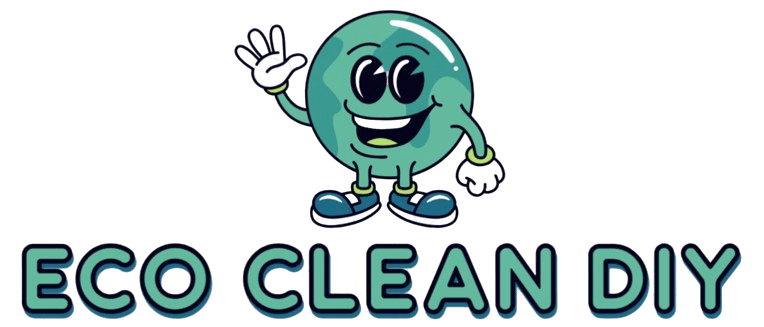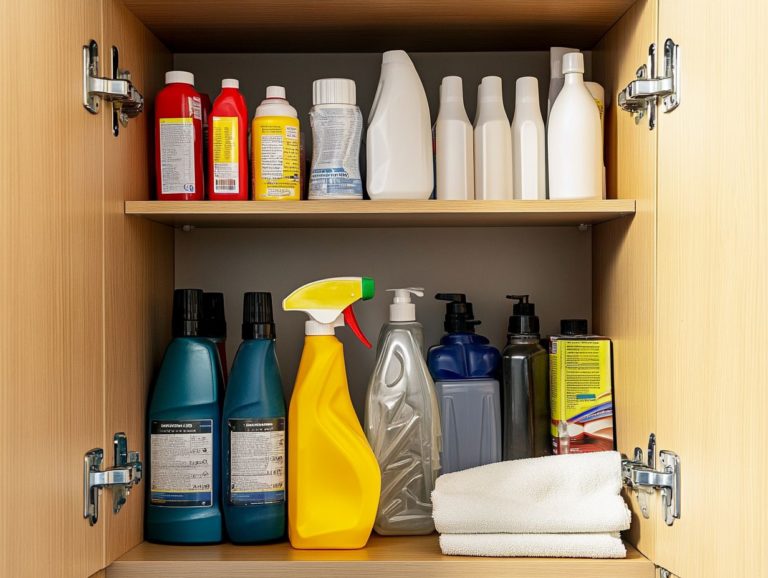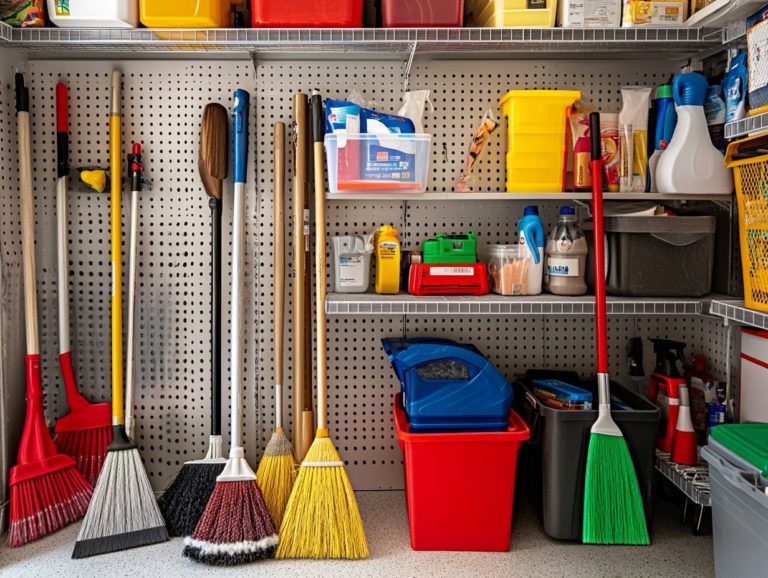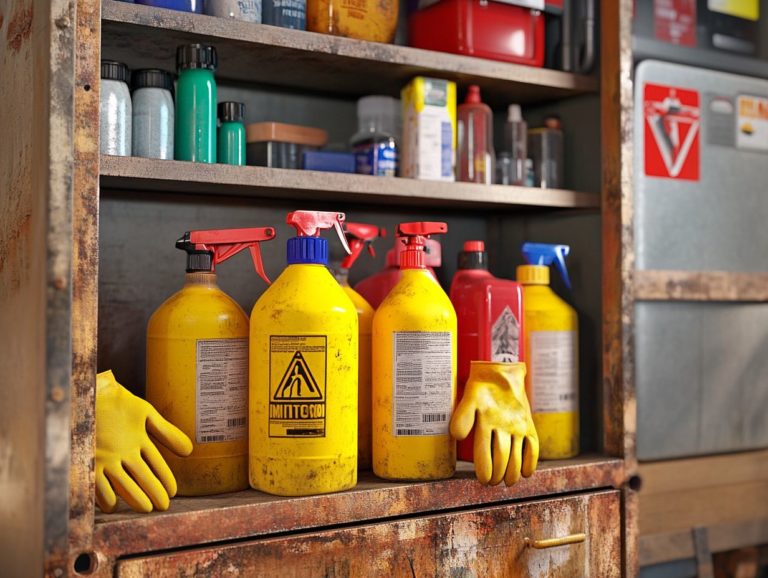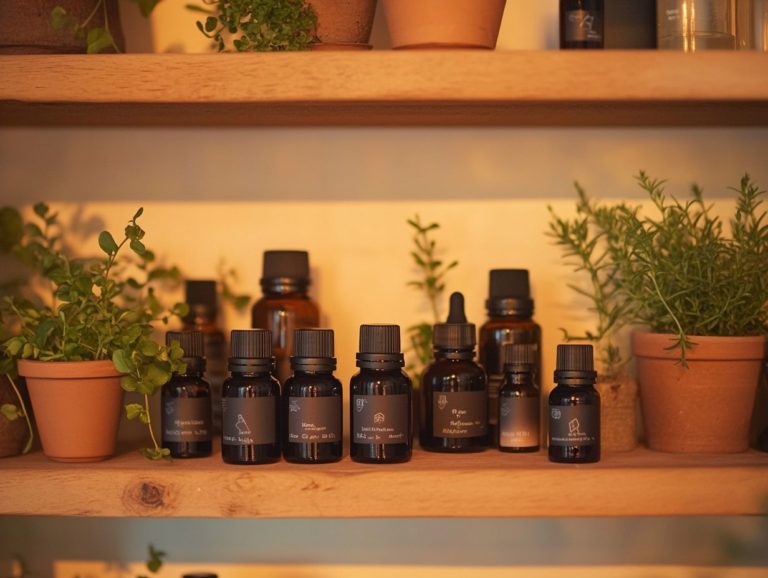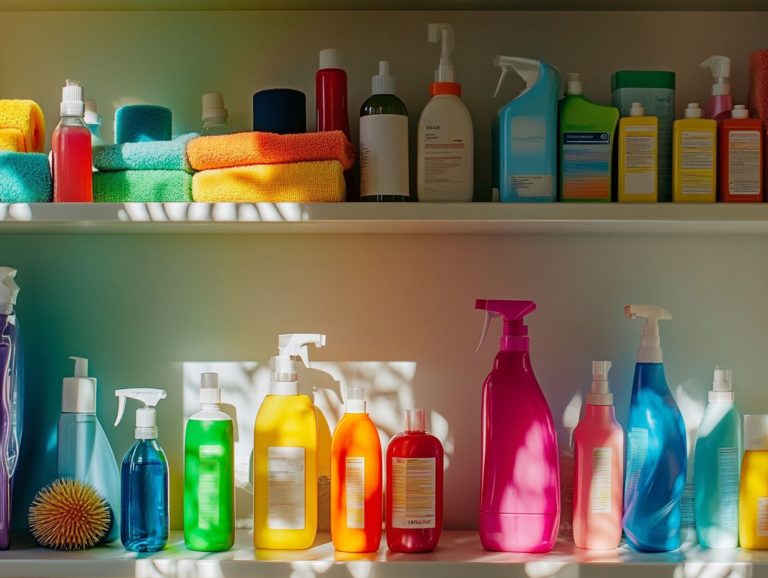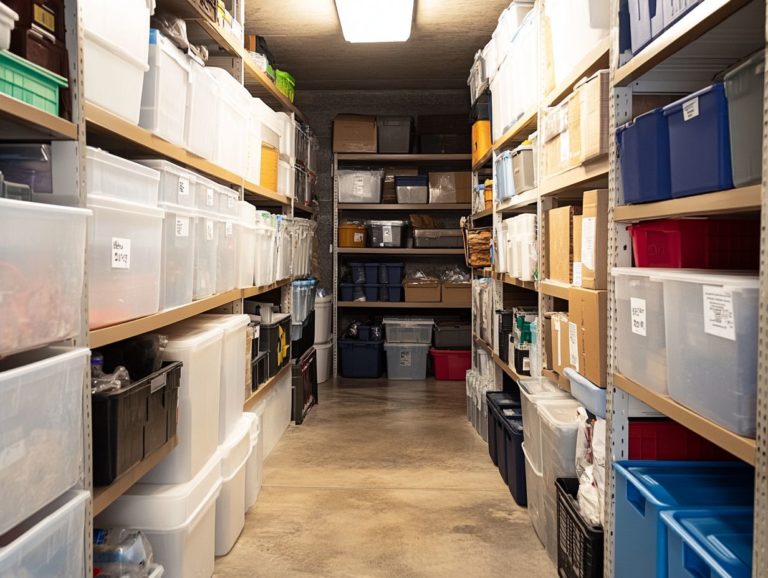How to Ensure a Safe Cleaning Environment
A clean environment is essential for your health and well-being, providing the foundation for a safe and productive life within healthcare facilities and other settings.
Understanding the importance of cleanliness and the risks associated with neglecting it is vital. From the proliferation of germs to the potential for accidents and the spread of infection, the ramifications of an unclean space can be significant.
Discover essential cleaning supplies that will make your environment safe! You will also learn effective scheduling strategies and best practices that promote a hygienic environment, including the use of personal protective equipment (PPE). Uncover the keys to ensuring a safe and clean space for everyone involved.
Contents
- Key Takeaways:
- Why Clean Spaces Matter: Protecting Health and Safety!
- The Hidden Dangers of Untidy Spaces: Know the Risks!
- What Are the Essential Cleaning Supplies?
- How to Create an Effective Cleaning Schedule?
- What Are the Best Practices for Maintaining a Clean Environment?
- Frequently Asked Questions
- What is the importance of keeping a cleaning area safe?
- What are some basic steps to ensure a safe cleaning area?
- How can I ensure the safety of my cleaning tools and equipment?
- Are there any specific precautions I should take when using cleaning chemicals?
- What are some tips for maintaining a safe cleaning area in a shared space?
- What should I do if I encounter a hazardous situation while cleaning?
Key Takeaways:
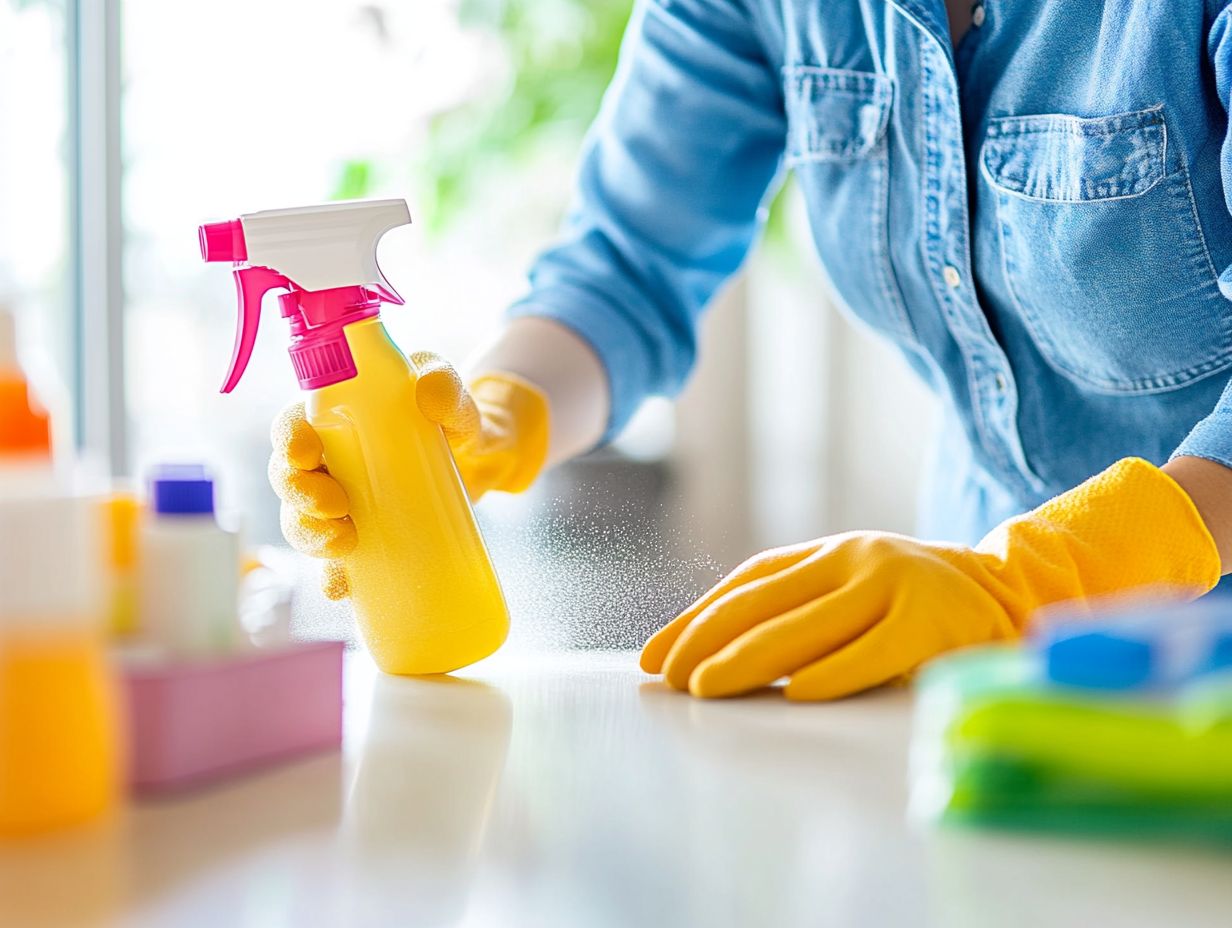
- A clean environment is crucial for good health and preventing the spread of germs and illnesses.
- An unclean environment can lead to accidents and increased infection rates.
- Use essential cleaning supplies, create a cleaning schedule, and regularly disinfect high-touch surfaces.
Why Clean Spaces Matter: Protecting Health and Safety!
Importance of Cleanliness in Healthcare
A pristine environment is crucial in healthcare facilities to guarantee the safety and well-being of patients, staff, and visitors alike. By upholding rigorous cleanliness standards, you effectively mitigate the spread of infectious pathogens such as MRSA, VRE, CRE, Cryptococcus neoformans, and Acinetobacter baumannii, which can easily flourish in untidy surroundings.
Prioritizing cleanliness enables healthcare institutions to improve indoor air quality and reduce infection rates. This commitment promotes a healthier atmosphere for everyone involved and safeguards public health. It also fosters greater efficiency in patient care.
The Hidden Dangers of Untidy Spaces: Know the Risks!
Risks in Healthcare Settings
An unclean environment presents substantial risks, especially in healthcare settings, where the presence of bacteria, viruses, and pathogens can culminate in serious health complications. Contaminated surfaces and inadequate waste management accelerate the spread of infections, placing vulnerable patient populations at greater risk and elevating the likelihood of healthcare-associated infections (HAIs).
Poor environmental hygiene also degrades indoor air quality. Without the use of thorough cleaning methods and infection prevention protocols, healthcare facilities may inadvertently transform into breeding grounds for harmful microorganisms. Regular inspections and adherence to cleanliness guidelines are essential in sustaining a safe environment.
1. Spread of Germs and Illnesses
The unchecked spread of germs and illnesses should be a major concern for you, especially in unclean environments like healthcare facilities, where patients with weakened immune systems are particularly vulnerable. Pathogens such as MRSA, VRE, and other harmful bacteria thrive on high-touch surfaces, leading to outbreaks that can be deadly if not managed effectively through rigorous cleaning and disinfection protocols.
In these settings, the transmission of pathogens primarily occurs through direct contact, respiratory droplets, or contaminated surfaces, highlighting the urgent need for effective hygiene practices. Healthcare-associated infections (HAIs) present significant risks, extending hospital stays and increasing healthcare costs and mortality rates. Patient education and visitor restrictions can also play a role in minimizing infection risks.
To tackle these challenges, you must implement a combination of routine cleaning schedules, specialized disinfectants that target a wide range of pathogens, and thorough staff training on hygiene practices. By adopting these strategies, you can significantly reduce the likelihood of infections, creating a safer environment for vulnerable patients and promoting overall public health within the community.
2. Risk of Accidents and Injuries
An unclean environment can significantly heighten the risk of accidents and injuries in healthcare settings. Slip and fall incidents may emerge from spills or cluttered areas. Upholding cleanliness is not merely about infection prevention; it is also essential for ensuring the safety and well-being of both patients and healthcare staff.
By implementing regular cleaning routines and effective spill management protocols, you can effectively mitigate these risks. Proper training on cleaning agents and the use of gear used to protect healthcare workers from exposure to harmful substances like gloves and masks is also critical in minimizing accidents.
In the fast-paced world of healthcare facilities, hygiene practices are key to preventing accidents! When surfaces are consistently sanitized, the chances of slippery floors and obstructed pathways diminish, creating a secure environment for everyone. It s crucial for staff to be well-trained in best practices, including the use of appropriate cleaning agents and the prompt reporting of hazards.
Implementing effective cleaning methods and protocols ensures a safer environment. Establishing a consistent cleaning schedule, particularly in high-traffic areas, not only removes potential dangers but also reassures patients about their safety.
Strategically placing signs can alert individuals about wet floors and clutter, further enhancing safety and minimizing incidents. By adhering to these protocols, including regular inspections, you ultimately foster a safer, more welcoming atmosphere for all.
3. Attracting Pests and Insects
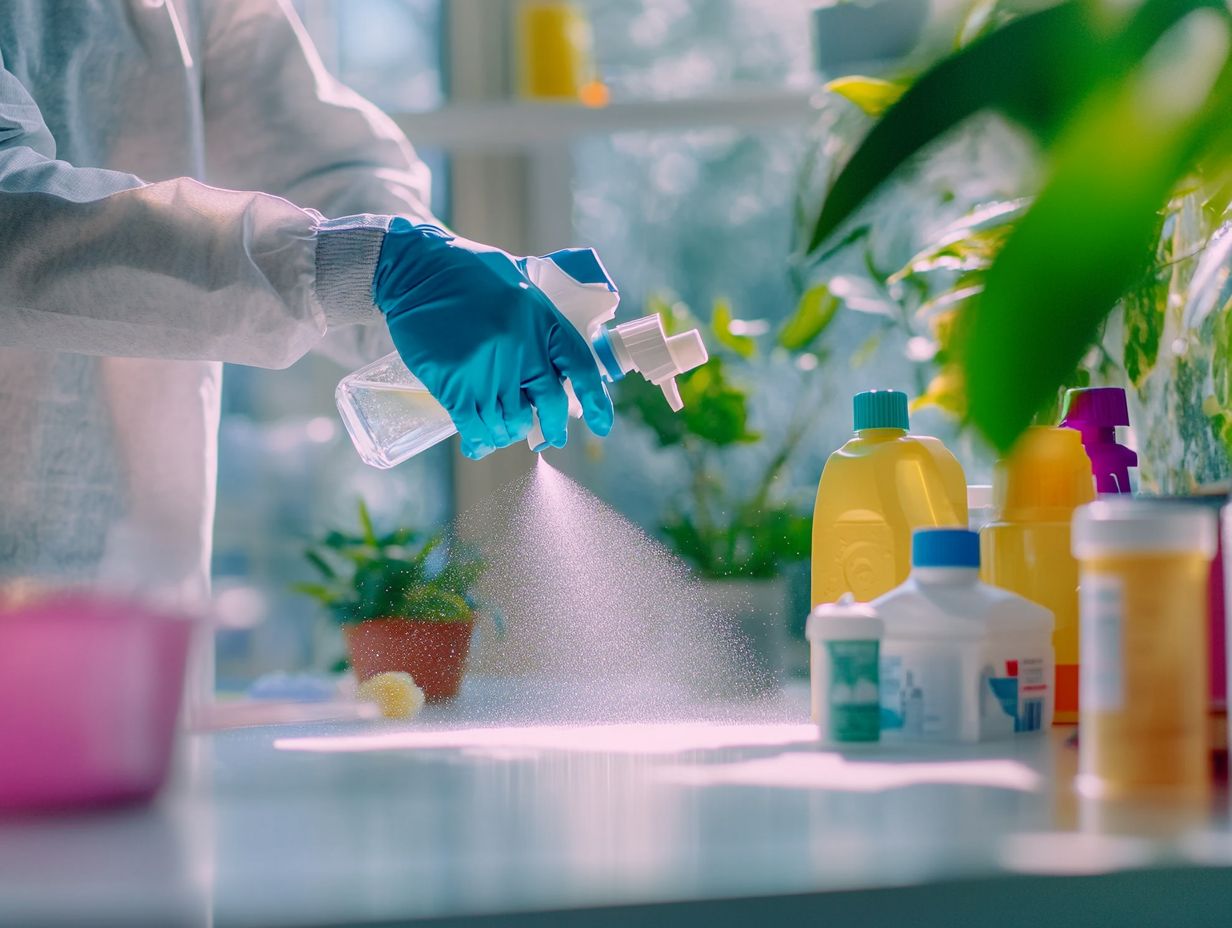
An unclean environment can easily attract pests and insects, introducing additional health hazards within healthcare facilities. The presence of poor waste management and biological waste can lead to infestations of rodents, flies, and other pests. This jeopardizes patient safety and undermines overall cleanliness.
You must implement rigorous cleaning schedules immediately to protect everyone s health and effective waste management protocols to prevent such infestations. In healthcare settings, you may encounter common pests like cockroaches, which can provoke asthma and allergic reactions, or mosquitoes, notorious carriers of diseases such as the West Nile virus.
The presence of these pests can compromise sterile environments, heightening the risk of hospital-acquired infections. To mitigate these risks, prioritizing cleanliness in your facilities is crucial. Ensure that all surfaces are regularly disinfected and that waste, particularly hazardous and biohazardous materials, is disposed of promptly and correctly.
Training your staff on hygiene practices and integrating pest control measures into your overall facility maintenance plans are vital strategies for fostering a safer environment for both patients and healthcare workers. Proper waste management and routine inspections are also essential components of a comprehensive cleaning strategy.
What Are the Essential Cleaning Supplies?
Key Cleaning Products and Tools
Essential cleaning supplies are vital for upholding cleanliness and hygiene in healthcare facilities. These supplies encompass a range of cleaning agents and disinfectants meticulously crafted to combat pathogens, ensuring that high-touch surfaces are effectively sanitized.
Effective cleaning methods and regular inspections are crucial to maintain these standards. Furthermore, gear used to protect healthcare workers from exposure to harmful substances like gloves and masks is essential for the safety of staff during cleaning procedures. These items are crucial because they protect staff from harmful cleaning agents.
1. Disinfectants and Cleaners
Disinfectants and cleaners are vital elements of effective cleaning protocols in healthcare facilities. They are carefully made to kill germs and ensure surfaces are properly sanitized.
These cleaning products significantly reduce the risk of infection by targeting bacteria, viruses, and other harmful microorganisms that tend to linger on surfaces, especially in high-touch areas. The use of commercial cleaning products and janitorial services can further enhance sanitization efforts.
You ll find a wide variety of disinfectants at your disposal, from alcohol-based wipes that are perfect for swiftly cleaning small surfaces to bleach solutions that deliver a more potent germicidal action for heavily contaminated areas. For instance, you might appreciate hydrogen peroxide for its broad effectiveness against various viruses.
Quaternary ammonium compounds, which are cleaning agents used to kill bacteria and viruses, are often the go-to choice for non-porous surfaces due to their user-friendly nature and residue-free finish. Proper training on these cleaning solutions ensures their effective and safe use.
Choosing the right cleaner is exciting and essential for a safe environment! Different surfaces such as countertops, medical equipment, and textiles may require specific formulations to ensure not just sanitation but also the preservation of the material’s integrity.
By understanding the unique properties of these disinfectants and adhering to established protocols, you can be confident that healthcare professionals are equipped with the right tools to maintain a safe environment.
2. Cleaning Tools and Equipment
Cleaning tools and equipment are absolutely vital for maximizing the effectiveness of cleaning methods in healthcare facilities. Whether it s mops and brooms or advanced electrostatic disinfection devices, using the right tools ensures efficient and thorough cleaning.
Regular inspections are essential to maintain their functionality and effectiveness in preventing infections. Healthcare facilities often rely on janitorial services to uphold these high standards.
In the healthcare sector, specialized cleaning implements serve unique and important roles. For example, microfiber cloths are far superior at trapping dirt and bacteria compared to traditional cloths, significantly enhancing sanitation standards.
Floor scrubbers and vacuum cleaners equipped with HEPA filters are also essential for removing allergens and pathogens from high-traffic areas, creating a safe environment for everyone both staff and patients alike.
Janitorial services act as the backbone of these healthcare facilities, ensuring that cleaning protocols, including waste management and spill management, are not just followed but are regularly evaluated through routine inspections. This ongoing commitment to cleanliness and infection prevention is crucial, directly influencing patient outcomes and overall hygiene within the facility.
3. Personal Protective Equipment (PPE)
Personal protective equipment (PPE) is absolutely essential in healthcare settings. It ensures your safety while tackling cleaning tasks.
Items like gloves, masks, and gowns serve as your first line of defense against exposure to harmful cleaning agents and pathogens, fostering a safe and healthy environment for both you and the patients in your care.
In addition to these vital essentials, you might also consider using safety goggles and face shields to safeguard against splashes from disinfectants, such as those effective against MRSA and VRE, that are frequently used during cleaning and disinfection processes.
Wearing PPE is not just a recommendation; it’s your best protection against harmful agents while ensuring a safe space for everyone!
Opting for high-quality, well-fitted PPE not only reduces the risk of accidental exposure to infectious materials but also boosts your overall efficiency and confidence in upholding hygiene standards.
It’s crucial for healthcare facilities to provide training on the correct use of PPE, ensuring that you are well-informed about its importance in maintaining a safe working environment. This proactive approach not only protects your health but also enhances the well-being of the patients you serve.
How to Create an Effective Cleaning Schedule?
Crafting a comprehensive cleaning schedule is essential for upholding hygiene standards and cleanliness guidelines in healthcare facilities. This ensures that every cleaning requirement is systematically addressed.
A thoughtfully structured schedule outlines the frequency of cleaning tasks and pinpoints high-touch surfaces that demand regular attention. It also includes routine inspections to evaluate cleanliness levels.
This proactive approach not only prevents the spread of infections from germs that can cause infections like CRE and Acinetobacter but also enhances overall safety within the facility.
1. Assess the Cleaning Needs
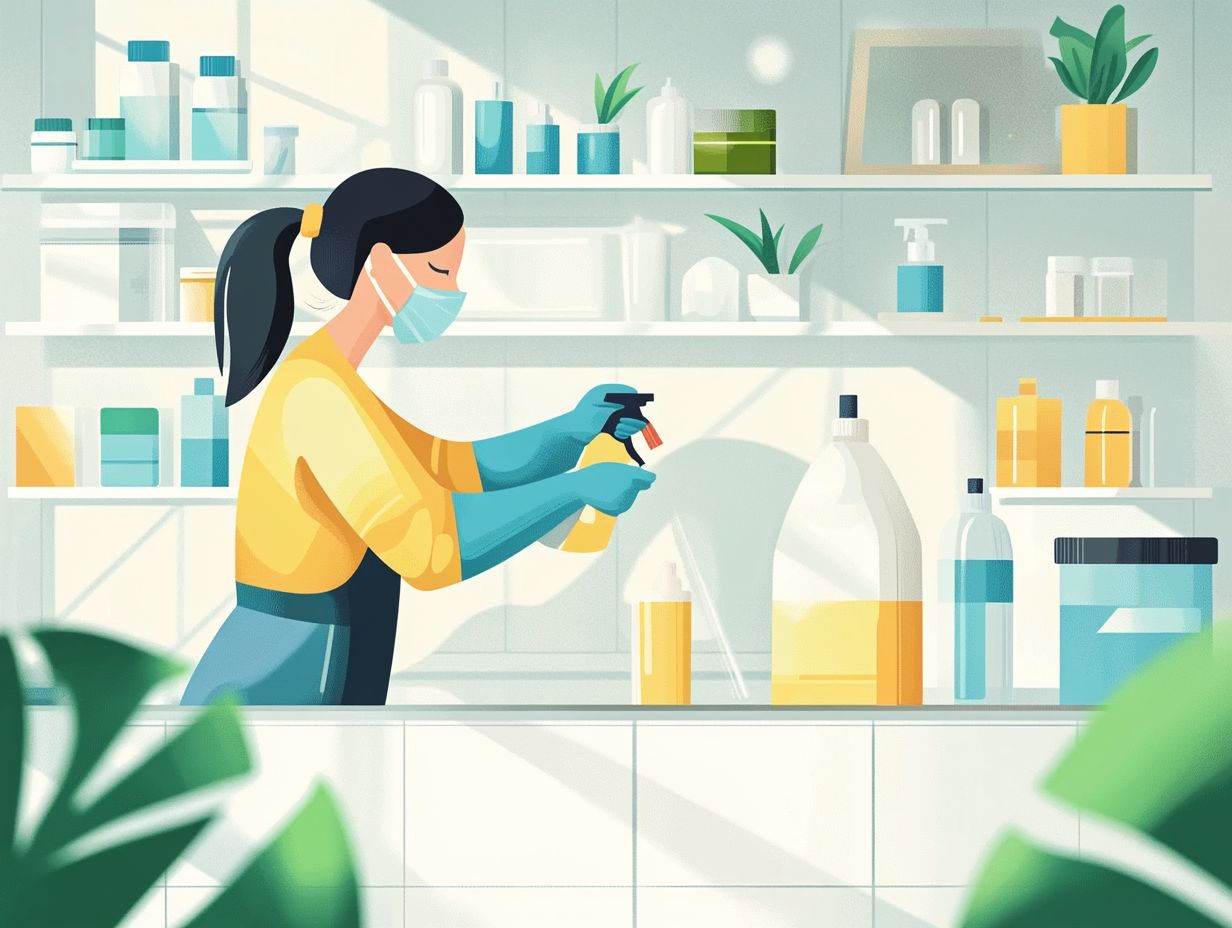
Assessing your cleaning needs is an essential first step in crafting an effective cleaning schedule for healthcare facilities. This enables you to adopt a tailored approach to maintaining cleanliness.
This process involves evaluating specific areas that require frequent attention, identifying high-touch surfaces, and considering the overall cleanliness levels observed during routine inspections. Examine the layout of the facility to find areas where contamination from germs like Cryptococcus is more likely to occur.
Gather feedback from staff and utilize resources such as infection control requirements rules to prevent the spread of germs that could lead to illness to assist you in determining the appropriate cleaning frequencies and methods.
2. Assign Tasks and Responsibilities
Assigning tasks and responsibilities is essential for crafting an effective cleaning schedule. This ensures every cleaning duty is clearly defined and understood by your staff.
By providing proper training and education, you equip your team with the necessary knowledge to execute their responsibilities efficiently and adhere to established cleanliness protocols. To nurture a sense of accountability, encourage open lines of communication among team members.
This allows them to discuss challenges and offer feedback on task assignments. Such a collaborative approach enhances team dynamics and gives the power to your cleaning staff to take ownership of their roles.
Incorporating training sessions that emphasize safety standards, cleaning techniques, and time management can lead to significant improvements in performance outcomes. Regular check-ins and assessments help identify any knowledge gaps, providing ongoing support while underscoring the importance of responsible task management.
By emphasizing these strategies, you can establish a well-coordinated cleaning operation, ensuring that high standards are consistently met.
3. Set a Schedule and Stick to It
Establishing a cleaning schedule and sticking to it is crucial for maintaining a high standard of cleanliness and hygiene across healthcare facilities. A structured approach guarantees that every area receives the necessary attention at consistent intervals.
This minimizes the risk of infection and fosters a safe environment for both patients and staff. To implement an effective cleaning schedule, it s essential to define specific tasks, assign responsibilities, and establish realistic timeframes.
Consistency is key to success; adhering to routines significantly enhances the overall hygiene of the facility. Accountability is equally important; staff members need to understand their roles and recognize the impact of their contributions.
Regular assessments and feedback mechanisms will help keep everyone aligned with the standards. Utilizing checklists, maintaining cleaning logs, and conducting routine inspections are all effective strategies that ensure compliance and evaluate the effectiveness of the cleaning regimen.
This approach creates a strong culture of cleanliness that everyone will notice and ultimately benefits everyone involved.
4. Monitor and Adjust as Needed
Monitoring the effectiveness of your cleaning schedule is essential for pinpointing areas that need adjustments to elevate cleanliness and hygiene standards. Regular inspections and feedback from your staff yield valuable insights into how well your current cleaning methods are working.
To ensure your cleaning practices meet the highest standards, adopt a structured plan for continuous monitoring and evaluation, including regular COVID-19 cleaning protocols. Collecting feedback from your team about their experiences with the cleaning protocols and conducting routine inspections to gauge compliance with established standards is key.
Utilizing checklists, observation forms, and electrostatic disinfection an effective method that uses charged particles to help disinfect surfaces during these inspections helps identify trends and areas ripe for improvement. Keeping communication channels open encourages your personnel to voice their concerns, leading to informed adjustments that significantly enhance the overall effectiveness of your cleaning schedule.
The synergy of ongoing assessments and proactive feedback contributes to a healthier, more productive environment for everyone involved.
What Are the Best Practices for Maintaining a Clean Environment?
Implementing best practices for maintaining a pristine environment is vital for effective infection prevention and cleaning in healthcare facilities. Establish routine cleaning protocols that prioritize high-touch surfaces and adhere to stringent cleanliness guidelines to significantly mitigate the risk of infection from bacteria and viruses.
1. Regularly Disinfect High-Touch Surfaces
Regularly disinfecting high-touch surfaces is crucial in healthcare settings, as it significantly reduces the presence of pathogens like acinetobacter baumannii and helps prevent infections. Surfaces such as doorknobs, light switches, and bedrails are frequently touched by multiple individuals, making them prime spots for the transmission of harmful bacteria and viruses like cryptococcus neoformans.
This underscores the necessity of establishing a rigorous disinfection protocol within your healthcare facility. By creating a routine for sanitizing these surfaces, you can substantially reduce the risk of cross-contamination, which is when germs are transferred from one surface to another.
Utilizing appropriate disinfectants that meet industry standards and following a clear cleaning schedule for these areas is vital. Best practices include:
- Using disposable cloths
- Allowing adequate contact time for chemical agents to work effectively
- Regularly reviewing protocols
Staff training empowers your team with knowledge about pathogens, fosters accountability, and ensures that everyone is well-versed in effective cleaning techniques. By implementing these strategies, you contribute to a safer environment for both patients and healthcare workers alike.
2. Keep Cleaning Supplies Organized and Accessible
Keeping your cleaning supplies organized and easily accessible is essential for maintaining efficiency in the cleaning practices of healthcare facilities. This includes commercial cleaning products and advanced cleaning solutions. When your cleaning agents and tools are at your fingertips, you can perform your duties promptly, ensuring a consistently clean environment that bolsters infection prevention efforts.
One effective strategy for achieving this organization is to categorize your supplies based on their use think disinfectants, mops, and tools and store them in clearly labeled containers. This approach enhances accessibility and significantly reduces the time spent hunting for specific items, streamlining your processes.
Implementing a central cleaning supply station can elevate your efficiency even further, allowing quick replenishment of your materials. An organized system directly correlates with improved cleanliness, which is vital for preventing the spread of infections and maintaining a high standard of hygiene. This structure fosters a more productive atmosphere, enabling you to focus on your primary task of maintaining a hygienic environment.
3. Properly Dispose of Waste and Garbage
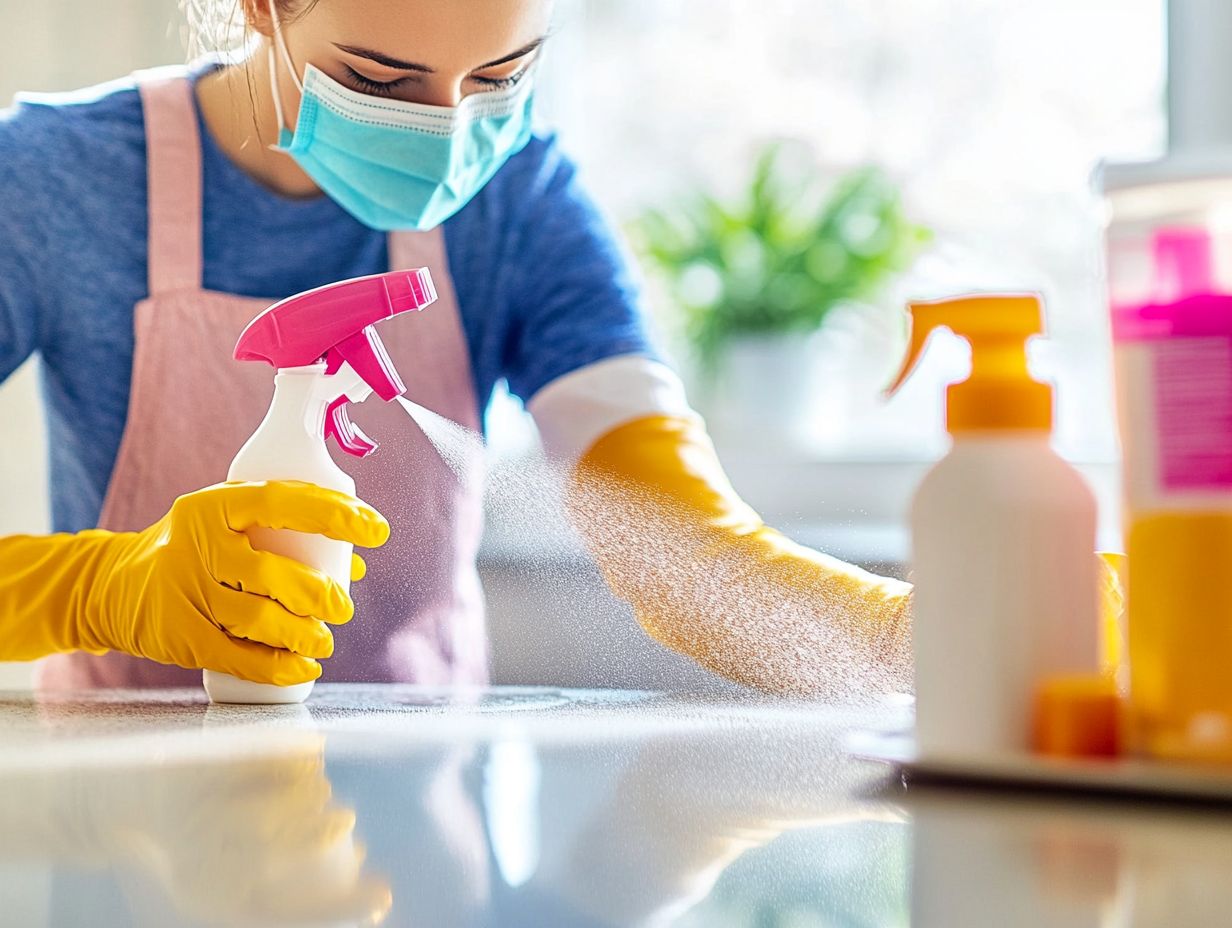
Effective waste management is crucial in healthcare settings, where maintaining a clean and safe environment is essential. This involves ensuring the correct disposal of biological waste, general garbage, and cleaning agents. Strict adherence to established protocols minimizes the risk of infection and upholds hygiene standards throughout the facility.
Neglecting proper waste disposal can lead to serious health risks, such as the potential spread of infections and exposure to hazardous materials for both staff and patients. It is essential for healthcare facilities to implement comprehensive waste management strategies that include segregation, accurate labeling, spill management, and disposal in accordance with regulatory standards.
Your role in this process is vital. Staff training and routine inspections are key to ensuring that everyone understands the importance of proper disposal methods. Recognizing their direct impact on patient safety and public health is crucial. By committing to consistent education and regular assessments, you can help foster a culture of compliance, ultimately protecting everyone within the healthcare environment.
4. Encourage Good Hygiene Habits
Encouraging good hygiene habits among staff and patients is important for maintaining a clean environment in healthcare facilities. Actively promoting practices such as frequent handwashing, visitor restrictions, and adherence to cleanliness guidelines can significantly reduce the risk of infection and create a culture of safety.
To enhance this initiative, implement educational programs like workshops and informational sessions that emphasize the importance of hygiene. These programs should cover key topics such as:
- The proper techniques for handwashing.
- The significance of using personal protective equipment (PPE), which includes gloves and masks.
- Tips for keeping personal and communal spaces clean.
- Understanding infection prevention protocols.
Customizing training programs for both staff and patients will deepen understanding and compliance, transforming hygiene practices into habits. When everyone within the facility embraces these strategies, the overall cleanliness will improve, shielding against infectious diseases like MRSA, VRE, and CRE, while fostering a healthier atmosphere conducive to healing and care.
Frequently Asked Questions
What is the importance of keeping a cleaning area safe?
Keeping a cleaning area safe is crucial for the health and well-being of individuals in a space. It helps prevent the spread of pathogens like bacteria and viruses, reduces the risk of accidents and injuries, and promotes overall cleanliness.
What are some basic steps to ensure a safe cleaning area?
Basic steps include wearing appropriate personal protective equipment (PPE), using labeled cleaning products, following effective cleaning procedures, and properly storing and disposing of cleaning materials.
How can I ensure the safety of my cleaning tools and equipment?
To ensure safety, regularly clean and disinfect your tools and equipment, store them in designated areas, and replace any damaged or worn-out items. Using advanced methods like electrostatic disinfection can further enhance safety and efficiency. Electrostatic disinfection uses charged particles to evenly coat surfaces, ensuring thorough cleaning.
Are there any specific precautions I should take when using cleaning chemicals?
Yes, always follow the instructions and warnings on cleaning product labels. Wear appropriate PPE, properly dilute and handle chemicals to avoid hazards. Keeping a cleaning schedule and using environmental services can also help manage chemical safety.
In a shared space, regularly communicate and coordinate with others on cleaning responsibilities. Properly label and store cleaning products, and ensure proper ventilation while cleaning to mitigate health risks. Adopting commercial cleaning and janitorial services can further help maintain a safe environment.
What should I do if I encounter a hazardous situation while cleaning?
If you encounter a hazardous situation while cleaning, stop and assess the situation. If necessary, contact emergency services and follow proper procedures for handling the specific hazard. It is also important to report any incidents to the appropriate authorities.
Ongoing training and regular inspections can help prepare staff for such scenarios.
